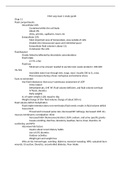Exam (elaborations)
Med Surg Exam 2 Complete study guide|Galen College of Nursing - NUR 242 MS Exam 2.
- Course
- Institution
Med Surg Exam 2 Complete study guide|Galen College of Nursing - NUR 242 MS Exam 2.Chap 11 Fluid compartments Intracellular 60% Contained within the cell body About 25L Veins, arteries, capillaries, heart, etc Extracellular 33% Most important area of homeostasis, area outside of cells Divide...
[Show more]



